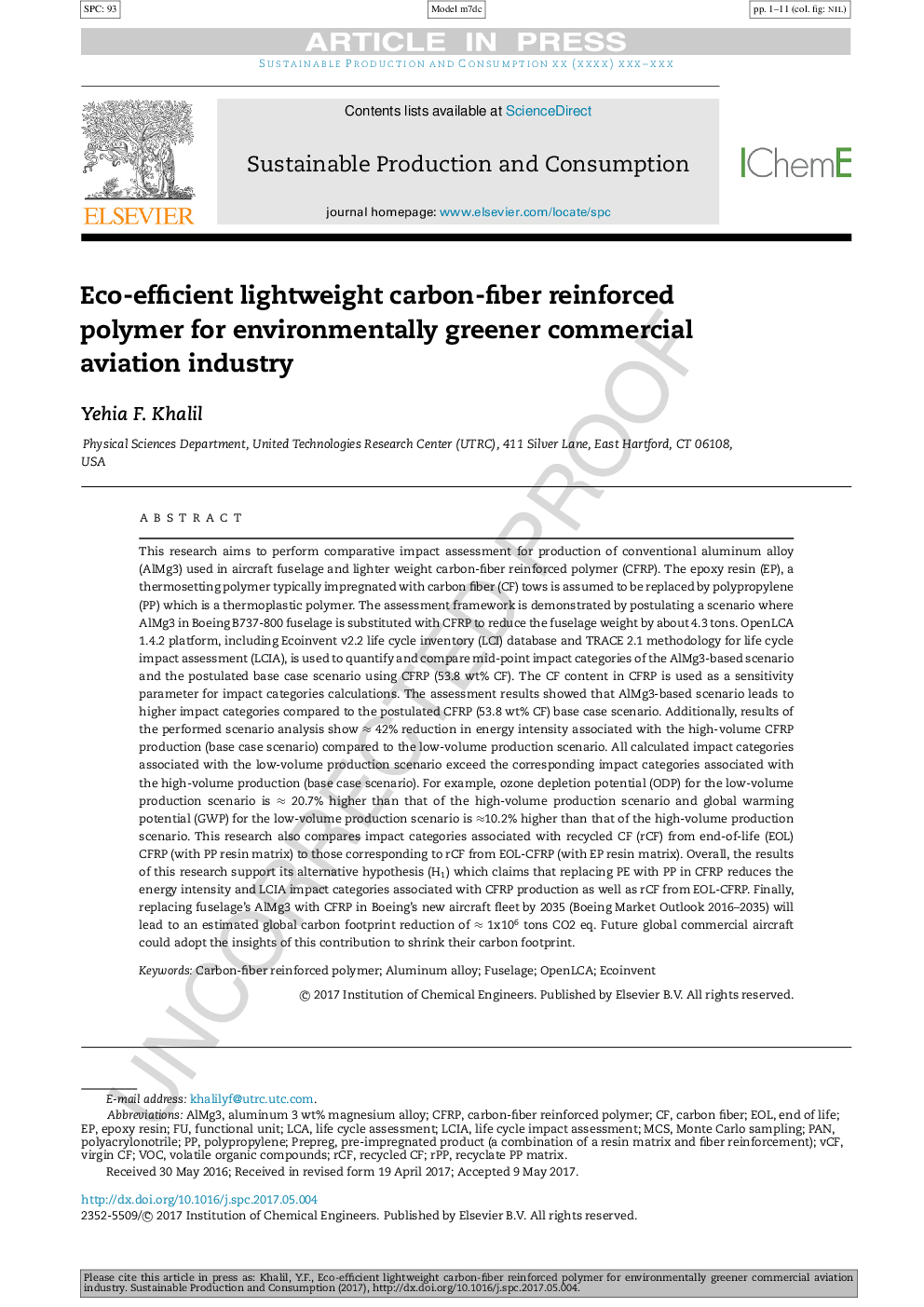| کد مقاله | کد نشریه | سال انتشار | مقاله انگلیسی | نسخه تمام متن |
|---|---|---|---|---|
| 4999483 | 1460558 | 2017 | 11 صفحه PDF | دانلود رایگان |
عنوان انگلیسی مقاله ISI
Eco-efficient lightweight carbon-fiber reinforced polymer for environmentally greener commercial aviation industry
ترجمه فارسی عنوان
پلیمرهای تقویت شده با کربن سبک با کارآیی سازگار با محیط زیست برای صنعت هواپیمایی تجارت سبز
دانلود مقاله + سفارش ترجمه
دانلود مقاله ISI انگلیسی
رایگان برای ایرانیان
کلمات کلیدی
LCIACFRPPrepregEOLrPPVCFVOCecoinventMCsRCFAluminum alloy - آلیاژهای آلومینیوم Life cycle impact assessment - ارزیابی تاثیر چرخه زندگیLCA - ارزیابی چرخه حیاتLife Cycle Assessment - ارزیابی چرخه عمر یا چرخه حیاتFuselage - بدنهVolatile organic compounds - ترکیبات آلی فرارEpoxy resin - رزین اپوکسیCarbon fiber - فیبر کربنPAN - ماهی تابهMonte Carlo sampling - نمونه برداری مونت کارلوfunctional unit - واحد عملکردیend of life - پایان عمرPolypropylene - پلی پروپیلن
موضوعات مرتبط
مهندسی و علوم پایه
مهندسی شیمی
تکنولوژی و شیمی فرآیندی
چکیده انگلیسی
This research aims to perform comparative impact assessment for production of conventional aluminum alloy (AlMg3) used in aircraft fuselage and lighter weight carbon-fiber reinforced polymer (CFRP). The epoxy resin (EP), a thermosetting polymer typically impregnated with carbon fiber (CF) tows is assumed to be replaced by polypropylene (PP) which is a thermoplastic polymer. The assessment framework is demonstrated by postulating a scenario where AlMg3 in Boeing B737-800 fuselage is substituted with CFRP to reduce the fuselage weight by about 4.3 tons. OpenLCA 1.4.2 platform, including Ecoinvent v2.2 life cycle inventory (LCI) database and TRACE 2.1 methodology for life cycle impact assessment (LCIA), is used to quantify and compare mid-point impact categories of the AlMg3-based scenario and the postulated base case scenario using CFRP (53.8 wt% CF). The CF content in CFRP is used as a sensitivity parameter for impact categories calculations. The assessment results showed that AlMg3-based scenario leads to higher impact categories compared to the postulated CFRP (53.8 wt% CF) base case scenario. Additionally, results of the performed scenario analysis show â 42% reduction in energy intensity associated with the high-volume CFRP production (base case scenario) compared to the low-volume production scenario. All calculated impact categories associated with the low-volume production scenario exceed the corresponding impact categories associated with the high-volume production (base case scenario). For example, ozone depletion potential (ODP) for the low-volume production scenario is â 20.7% higher than that of the high-volume production scenario and global warming potential (GWP) for the low-volume production scenario is â10.2% higher than that of the high-volume production scenario. This research also compares impact categories associated with recycled CF (rCF) from end-of-life (EOL) CFRP (with PP resin matrix) to those corresponding to rCF from EOL-CFRP (with EP resin matrix). Overall, the results of this research support its alternative hypothesis (H1) which claims that replacing PE with PP in CFRP reduces the energy intensity and LCIA impact categories associated with CFRP production as well as rCF from EOL-CFRP. Finally, replacing fuselage's AlMg3 with CFRP in Boeing's new aircraft fleet by 2035 (Boeing Market Outlook 2016-2035) will lead to an estimated global carbon footprint reduction of â 1x106 tons CO2 eq. Future global commercial aircraft could adopt the insights of this contribution to shrink their carbon footprint.
ناشر
Database: Elsevier - ScienceDirect (ساینس دایرکت)
Journal: Sustainable Production and Consumption - Volume 12, October 2017, Pages 16-26
Journal: Sustainable Production and Consumption - Volume 12, October 2017, Pages 16-26
نویسندگان
Yehia F. Khalil,
